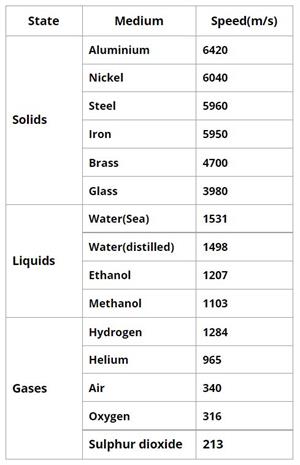
PUMPA - SMART LEARNING
எங்கள் ஆசிரியர்களுடன் 1-ஆன்-1 ஆலோசனை நேரத்தைப் பெறுங்கள். டாப்பர் ஆவதற்கு நாங்கள் பயிற்சி அளிப்போம்
Book Free DemoSound travels at a finite speed through a medium. The sound of thunder arrives a few seconds after the flash of light. As a result, we can deduce that sound travels at a much slower rate than light. The properties of the medium through which sound travels determine its speed. In a gaseous medium, sound travels slower than in a solid medium. When the temperature of a medium is increased, the speed of sound increases. The speed of sound in air, for example, is 330 at 0 °C and 340 at 25 °C.

The above table shows the sound speed in various media at 25° C.
When an object travels faster than the speed of sound in the air, it is said to be travelling supersonically. Bullets, jets, and planes, among other things, can travel at supersonic speeds. Shock waves are created when an object travels faster than the speed of sound in the air; these shock waves carry a large amount of energy, and the air pressure variations associated with this type of shock wave produce a very sharp and loud sound known as 'sonic boom.' An aircraft's shock waves have enough energy to shatter glass and even damage buildings.
Sound travels about five times faster in water than in air. Since the speed of sound in seawater is very large (being about 1530 , which is more than 5500 km/h), two whales in the sea, which are even hundreds of kilometres away, can talk to each other very easily through the seawater.